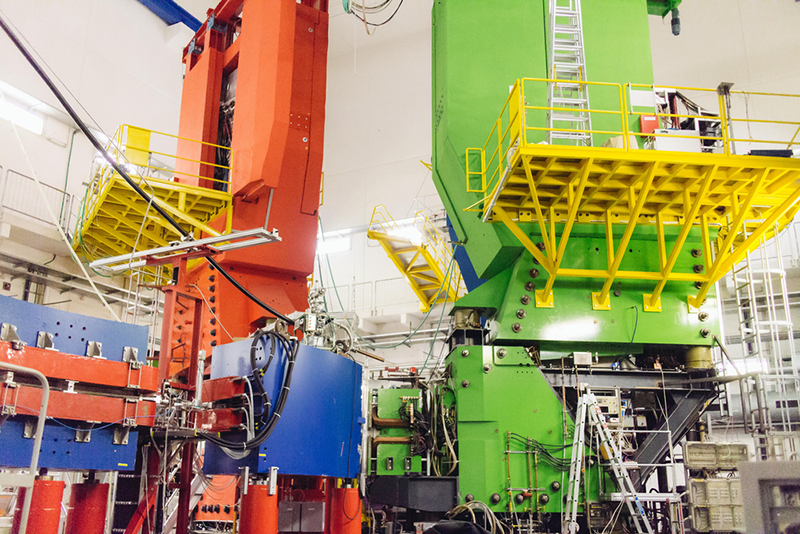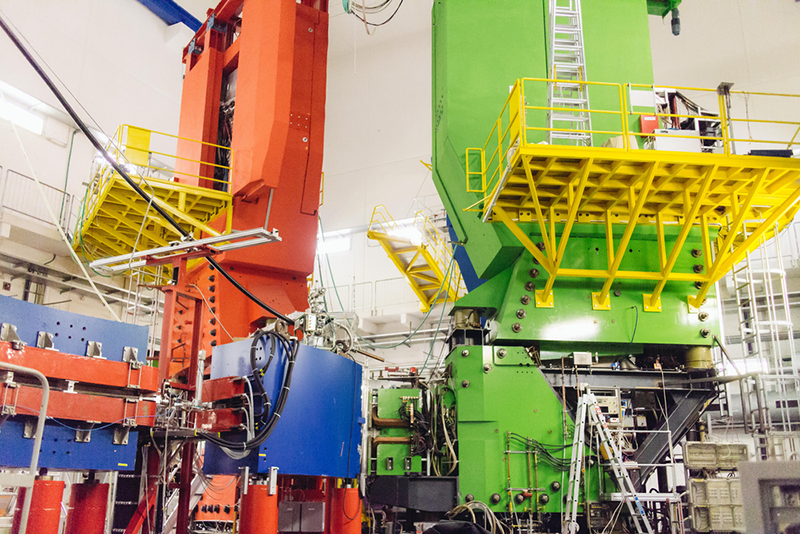Closing a Gap in Nuclear Theory
When a nucleus gains energy, its constituent neutrons and protons move into a new excited state, a change that makes the nucleus more unstable. For helium-4 (4He), the lowest excited nuclear state, labeled 0+2, lies just above one of the nucleus’s decay modes, making it “unbound,” a condition that has bedeviled the calculation of its properties. Emphasizing the computational challenge, a recent electron scattering experiment yielded a result that was off from predictions by 100% [1]. Now two independent groups of theorists have performed new calculations for the transition to 0+2, finding values of the associated resonance that match those obtained in experiments [2, 3]. The resolution of the discrepancy involved accounting for various aspects of nuclear modeling that had been missed in previous calculations, highlighting the challenge to theorists of understanding even the simplest of nuclei.
The recent electron scattering experiment took place at the Mainz Microtron (MAMI) in Germany. During a month-long campaign, researchers measured the differential cross section of a reaction that excites 4He to its 0+2 state. Thanks to its higher precision, the measurement widened the gap between the experimentally determined cross section and the theoretical approach that had been used to explain the data: chiral effective field theory ( 𝜒EFT).
Expressing nuclear interactions as perturbative expansions, 𝜒EFT can readily account for some properties of nuclei. But as Evgeny Epelbaum of Ruhr University Bochum, Germany, explains in a commentary about the Mainz experiment (see Viewpoint: Probing the Helium Nucleus beyond the Ground State), 𝜒EFT performs poorly for the 0+2 state of 4He, as truncating the expansion, which is what makes 𝜒EFT calculations tractable, can cause the calculations to exclude significant details.
Truncation errors are magnified for the transition to 0+2 because the state, being barely unbound, is a complicated superposition of states. Reaching the excited state entails a radical rearrangement of the neutrons (n) and protons (p), making its traditional interpretation as a vibrational excitation of the ground state potentially inappropriate. When they set out to calculate the properties of the 0+2 state, Nicolas Michel of the Chinese Academy of Sciences and his collaborators therefore recognized the need to keep track of the various reaction channels [2]. They also included one open decay channel (4He →3He + p) and two closed ones (4He →3He + n and 4He →2H + 2H). As well as reproducing the MAMI experimental cross section, the calculation revealed the sensitivity of the cross section to the 0+2 excitation energy in relation to the threshold energy of the decay channel.
Michel and his collaborators solved the four-body problem for 4He. They accounted for the unbound nature of the 0+2 state using a realistic treatment of interactions between pairs of nucleons and a somewhat simplified treatment of interactions among trios of nucleons. Meanwhile, Ulf Meißner of the University of Bonn, Germany, and his collaborators solved the many-body problem, including realistic interactions between pairs and trios of nucleons [3]. Although they did not consider the width of the 0+2 state, they obtained its correct energy. To do so, they used a minimal model of the nuclear interaction—that is, a representation of nuclear forces that leads to an overall description of the binding energies of light and medium-mass nuclei. Their calculation also reproduces the MAMI cross section. Meißner says that he sees his and Michel’s studies as implying that 𝜒EFT should be tested more systematically on the excited unbound states.
Despite the theorists’ successes, certain aspects of the experiment, such as the inconsistency with older low-energy data, remain unexplained, says Concettina Sfienti of the Johannes Gutenberg University Mainz, Germany. Sfienti was the principal investigator for the MAMI experiment. Scattering experiments at lower energies would, she says, “further clarify the mesh of agreements and disagreements.” Sonia Bacca, a colleague of Sfienti at the same university, emphasizes the need for further theoretical investigations to understand why the disagreement arose.
Clarifying where theory and experiment deviate has implications beyond nuclear physics. The physics embodied in the low-energy rearrangement of nucleons feeds into the equation of state of nuclear matter in neutron stars. Transitions among ground and excited states in light nuclei within stars underlie the synthesis of elements and, ultimately, the chemistry of the Universe.
–Charles Day
Charles Day is a Senior Editor for Physics Magazine.
References
- S. Kegel et al., “Measurement of the 𝛼-particle monopole transition form factor challenges theory: A low-energy puzzle for nuclear forces?” Phys. Rev. Lett. 130, 152502 (2023).
- N. Michel et al., “Description of the proton-decaying 0+2 resonance of the 𝛼 particle,” Phys. Rev. Lett. 131, 242502 (2023).
- U.-G. Meißner et al., “Ab initio calculation of the alpha-particle monopole transition form factor: No puzzle for nuclear forces,” arXiv:arxiv: 2309.01558.





